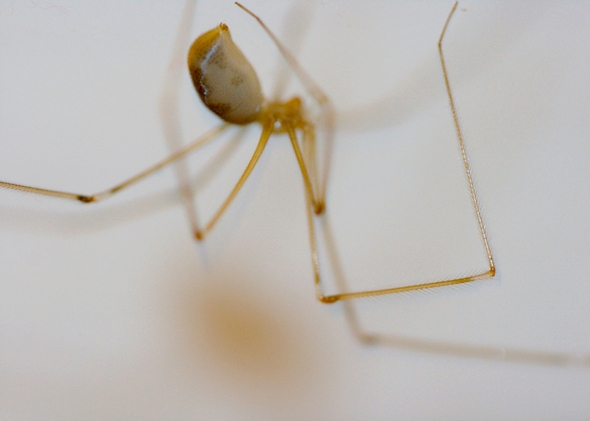That Viral Video of a Spider Clump Doesn’t Actually Show Spiders

Photo courtesy Ryan Poplin/Flickr/Creative Commons
Earlier this month, Vine user Pablo Barroeta of Cholula, Mexico, posted a video showing a seemingly innocuous fuzz ball resting on a blue plastic bin. (We'll embed it at the bottom for those who are brave enough to watch.) After he prods the mustache-like object with his finger, a pulsating mass of what look like spiders suddenly erupts and frenetically scurries down the walls of the bin. The video quickly went viral. Many viewers reacted in horror, and news outlets reported on the “wad of spiders.” But are these creatures really spiders?
No. They are arachnids—the class that includes spiders, scorpions, and ticks—but the creatures in the video are most likely harvestmen, a member of the opiliones order. They’re also referred to as daddy longlegs. Harvestmen are often confused with long-legged spiders, despite some key differences. Harvestmen do not possess silk glands and cannot build webs. They possess only one set of eyes, unlike spiders. Perhaps most reassuringly, no known species of harvestmen—more than 6,500 have been identified—has venom glands, and their bite is nowhere near capable of breaking human skin.
These creepy creatures live on every continent except Antarctica, and in nearly every climate. Other species are entirely troglodytic, living only in damp corners of caves. But Shelob they are not. Two endangered species, Texella reyesi and Texella reddelli, are so adapted to their Central Texas caves that they have no eyes at all, slowly crawling along the cave walls in search of tiny insect prey.
Harvestmen snack on things like lizard tails, feces, decaying plants, and fungus. They carefully drag each of their seven-jointed legs between their jaws to clean up after a meal. When attacked, the daddy longlegs are able to lose limbs and survive.* The detached limb will even twitch for several seconds to distract predators. Harvestmen also emit a stench when threatened, a foul-smelling milky liquid from a special scent gland, warning potential predators that they would not be very tasty. They secrete another liquid to form a scent trail that fellow harvestmen may follow.
So why would harvestmen clump together like those in the viral video? To avoid desiccation and death. In hot, dry climates, harvestmen are known to form groups of up to 70,000 individuals in order to retain moisture and protect against predators. When temperatures cool down at night, the resilient arachnids scatter to scavenge for food. If male daddy longlegs run into one another in the dark, they are known to joust upon meeting. (“Those are my dinner feces, back off!”)
Creepy? Yes. But the friendly harvestman doesn’t deserve your horrified reactions. They can’t bite, they can’t sting, and they even eat some common household pests. Next time you see one, don’t be afraid to pick one up with your hands, look into its tiny little eyes, and say hello. And if you see a giant blob of them, leave them alone! They’re just trying to beat the heat.
Thanks to Theresa Dellinger, diagnostician at Virginia Tech Department of Entomology Insect Identification Lab.
*Correction, Jan. 17, 2014: This post originally misstated that daddy longlegs can regrow lost limbs.
